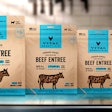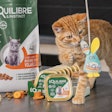
Health and wellness drive many pet owners decisions about what both they and their pets should eat. Fruit is widely considered a cornerstone of healthy eating for people, and fruits can also be nutritious parts of pet diets. However, other fruits can be deadly to dogs and other pets. For example, veterinarians have observed numerous cases of dogs poisoned by grapes, which may result from a chemical found in the fruit. Learn more about fruits that can be used in dog, cat and other pet foods in these excerpts from Petfood Industry’s Ingredient Issues.
An apple a day keeps the vet away … are apples safe for pets?
The benefit of apples has been extensively researched for humans, but does it apply to dogs and cats, as well? Hard to say. Not too surprisingly, there is little to no information available on feeding apples to pets in the academic literature, though there are quite a few studies evaluating apple pomace as a fiber source. Interestingly, there are many popular press articles in print and online that extoll the virtue of apples as a treat for dogs.
Alas, the poor cat is left out of this debate — again, most probably because apples as treats for dogs are more common and they have a sweet tooth (or taste receptor that the cat lacks).
Avocado in pet foods—guacamole for the dog and cat
When evaluated at a high concentration (>18% of the formula) in canine and feline diets (Dainton, 2018), a commercial avocado meal exchanged for beet pulp or cellulose had minimal impacts on extrusion conditions. It was more like beet pulp than cellulose regarding effects on digestibility and fecal fermentation end products. There was some note that palatability may have been affected with this high level of avocado meal. Blood work from these studies did not point to any acute issues with all parameters within normal ranges, but alkaline phosphatase and alanine aminotransferase were both higher in dogs and cats fed avocado meal containing diets. This might suggest a need for longer-term studies to confirm that there is no issue with toxicity.
Cranberries in dog and cat food: any direct benefit?
For those companies that do include cranberries in their foods, the levels of inclusion are typically small enough to not affect processing in extrusion, canning or baking. Further, work from White et al. (2011) suggests that the polyphenols in cranberries are relatively stable and availability may actually be improved as a result of processing. So, in the end, it appears that cranberries in pet food are relatively benign and might provide some benefit.
Blueberries: Does this superfood have a place in pet food?
There are very few reports in which blueberries have been evaluated in pet foods. Mostly in food for dogs and almost exclusively as an antioxidant in combination with other ingredients. The most potential benefit for pets is arresting the cognitive decline associated with aging.
More on pet food ingredients
To learn more about specific components of pet food, visit the Petfood Industry Knowledge Center, a collection of premium content for pet food industry professionals. This library contains more than 100 articles by nutritionist Greg Aldrich, PhD, published in Petfood Industry since 2005. Articles cover specific ingredients that are grouped by category.
Registered users may view the following sample article at no charge. Receive 12 months of unlimited access to the entire Ingredient Issues library for only $99.95. Purchase here. View free sample: Poultry by-product meal and poultry meal: Is there a difference?

















